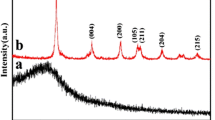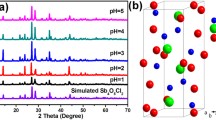Abstract
Bi2WO6 hollow microspheres were successfully synthesized by solvothermal process in the presence of urea at proper ethylene glycol (EG)/absolute ethanol (AE) volume ratio (1:1). The samples consisted of microspheres with an average diameter of 1 μm, and the shell consisted of numerous nanoplates. The effect of solvent, the ratio of EG/AE solvents and urea amount on the morphology of the samples was studied systematically, indicating that a certain ratio of EG/AE and urea amount played an important role in the formation of hollow microspheres. Based on the detailed investigation, the formation mechanism of the hollow interior by EG-induced Ostwald ripening process was proposed. By contrast, the Bi2WO6 hollow microspheres exhibited higher catalytic activity for degradation of Rhodamine B under xenon lamp irradiation, and nearly 100 % Rhodamine B is degraded within 120 min.
Graphical Abstract










Similar content being viewed by others
References
Zhu H et al (2009) Fast synthesis, formation mechanism, and control of shell thickness of CuS hollow spheres. Inorg Chem 48:7099–7104
Su Y, Yan R et al (2011) Synthesis of hierarchical hollow silica microspheres containing surface nanoparticles employing the quasi-hard template of poly(4-vinylpyridine) microspheres. Langmuir ACS J Surf Coll 27:8983–8989
Tong S et al (2011) Synthesis of mesoporous carbons from bituminous coal tar pitch using combined nanosilica template and KOH activation. Ind Eng Chem Res 50:13825–13830
Yu X, Yu J et al (2009) One-pot template-free synthesis of monodisperse zinc sulfide hollow spheres and their photocatalytic properties. Chem Eur J 15:6731–6739
Cao C-Y et al (2010) Ceria hollow nanospheres produced by a template-free microwave-assisted hydrothermal method for heavy metal ion removal and catalysis. J Phys Chem C114:9865–9870
Liu S, Huang G et al (2014) Porous fluorinated SnO2 hollow nanospheres: transformative self-assembly and photocatalytic inactivation of bacteria. ACS Appl Mater Interfaces 6:2407–2414
Shi R et al (2009) Photocatalytic activity enhancement for Bi2WO6 by fluorine substitution. J Phys Chem C113:19633–19638
Ma D, Huang S et al (2009) Self-assembled three-dimensional hierarchical umbilicate Bi2WO6 microspheres from nanoplates: controlled synthesis, photocatalytic activities, and wettability. J Phys Chem C113:4369–4374
Shang M et al (2009) New Bi2WO6 nanocages with high visible-light-driven photocatalytic activity prepared in refluxing EG. Cryst Growth Des 9:991–996
Voronkova V et al (2009) Refinement of Bi2WO6 and Bi2WO6 polymorphism. J Alloy Compd 487:274–279
Ghoshal T et al (2007) ZnO doughnuts: controlled synthesis, growth mechanism, and optical properties. Cryst Growth Des 7:136–141
Shen J et al (2012) 3D hierarchical ZnIn2S4: the preparation and photocatalytic properties on water splitting. Int J Hydrogen Energy 37:16986–16993
Chen Z et al (2010) Controlled synthesis of hierarchical Bi2WO6 microspheres with improved visible-light-driven photocatalytic activity. CrystEngComm 12:2100–2106
Li Y et al (2007) Hydrothermal synthesis of Bi2WO6 uniform hierarchical microspheres. Cryst Growth Des 7:1350–1355
Zhong LS et al (2006) Self-Assembled 3D flowerlike iron oxide nanostructures and their application in water treatment. Adv Mater 18:2426–2431
Yan C, Xue D (2006) Morphosynthesis of hierarchical hydrozincite with tunable surface architectures and hollow zinc oxide. J Phys Chem B110:11076–11080
Chen F et al (2013) 3D-hierarchical Cu3SnS4 flowerlike microspheres: controlled synthesis, formation mechanism and photocatalytic activity for H2 evolution from water. J Mater Chem A 1:4316–4323
Yang HG, Zeng HC (2004) Preparation of hollow anatase TiO2 nanospheres via Ostwald ripening. J Phys Chem B 108:3492–3495
Devaraju MK et al (2009) A fast and template free synthesis of Tb: Y2O3 hollow microspheres via supercritical solvothermal method. Cryst Growth Des 9:2944–2949
Wang X et al (2008) Self-assembled growth of hollow spheres with octahedron-like Co nanocrystals via one-pot solution fabrication. J Phys Chem C112:8773–8778
Lou XW et al (2006) Template-free synthesis of SnO2 hollow nanostructures with high lithium storage capacity. Adv Mater 18:2325–2329
Qiao R et al (2007) Preparation of magnetic hybrid copolymer–cobalt hierarchical hollow spheres by localized Ostwald ripening. Chem Mater 19:6485–6491
Li J, Zeng HC (2007) Hollowing Sn-doped TiO2 nanospheres via Ostwald ripening. J Am Chem Soc 129:15839–15847
Wang W-S et al (2006) Room temperature synthesis of hollow CdMoO4 microspheres by a surfactant-free aqueous solution route. J Phys Chem B110:23154–23158
Kudo A, Tsuji I, Kato H (2002) AgInZn7S9 solid solution photocatalyst for H2 evolution from aqueous solutions under visible light irradiation. Chemical communications 7:1958–1959
Xu M et al (2012) Band gap-tunable (CuIn) × Zn2(1−x) S2 solid solutions: preparation and efficient photocatalytic hydrogen production from water under visible light without noble metals. J Mater Chem 22:23929–23934
Tsunekawa S et al (2000) Blue shift in ultraviolet absorption spectra of monodisperse CeO2− × nanoparticles. J Appl Phys 87:1318–1321
Dai F et al (2014) Bottom-up synthesis of high surface area mesoporous crystalline silicon and evaluation of its hydrogen evolution performance. Nat Commun. doi:10.1038/ncomms4605
Bavykin DV et al (2004) The effect of hydrothermal conditions on the mesoporous structure of TiO2 nanotubes. J Mater Chem 14:3370–3377
Huang H et al (2012) Controllable synthesis and visible-light-responsive photocatalytic activity of Bi2WO6 fluffy microsphere with hierarchical architecture. J Coll Interface Sci 370:132–138
Fu H, Pan C et al (2005) Visible-light-induced degradation of rhodamine B by nanosized Bi2WO6. J Phys Chem B109:22432–22439
Acknowledgments
This study was supported by the Henan Fundamental and Frontier Technology Program (No. 082300420200), China, the Foundation of Henan Education Committee (2010B150015), China.
Author information
Authors and Affiliations
Corresponding author
Rights and permissions
About this article
Cite this article
Wang, X., Wan, X. & Chang, L. Solvothermal Synthesis of Bi2WO6 Hollow Microspheres Via Ostwald Ripening with Their Enhanced Photocatalytic Activity. Catal Lett 144, 1268–1277 (2014). https://doi.org/10.1007/s10562-014-1271-z
Received:
Accepted:
Published:
Issue Date:
DOI: https://doi.org/10.1007/s10562-014-1271-z




